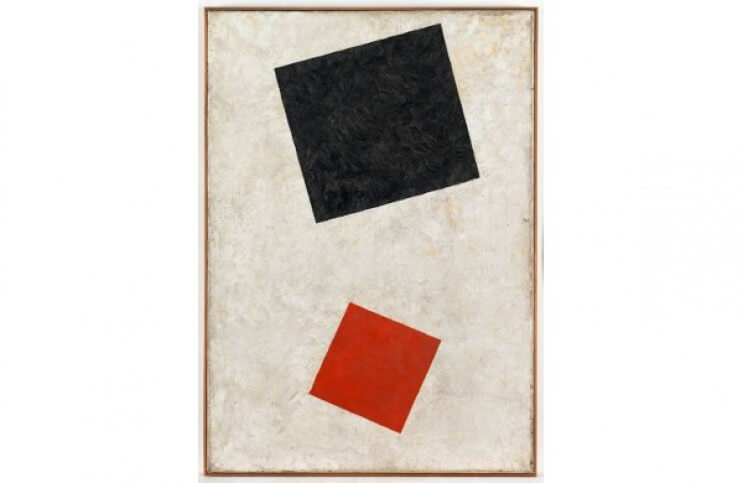
A €50 million Fake - The Story of Kasimir Malevich’s “Black Square, Red Square”
The recent story of an alleged Kasimir Malevich painting, Black Square, Red Square, has shone a potentially embarrassing light on two major cultural institutions in Germany: the Kunstsammlung Nordrhein-Westfalen, a museum complex in Düsseldorf that houses the official art collection of the German state of North Rhine-Westphalia, and the Wilhelm Hack Museum in Ludwigshafen, which houses the personal art collection of Dr. Wilhelm Hack (1899 - 1985). The painting, which was estimated to be worth as much as €50 million, turned out to be fake. But the professional way at least one of those institutions is handling the news of the forgery is proof the art world still has honest and dignified members amongst its ranks.
Who Was Wilhelm Hack?
The German city of Ludwigshafen looks relatively modern today. But in World War II, the city was all but destroyed. Even after being rebuilt (poorly) by Allied forces after the war, there were few architecturally interesting buildings in the city. It was partially for that reason—to bring a cultural highlight to a disadvantaged city—that Wilhelm Hack chose the city as the spot to build his personal museum. Hack was a German businessman who late in life devoted his efforts to accumulating a prestigious art collection. He built his museum in 1979 to share his collection with the public. Its Modernist exterior, which features a gargantuan mural by Joan Miró, is reason enough to put Ludwigshafen on a must-see list for anyone traveling to the region.
But there has always been a bit of controversy surrounding the Wilhelm Hack collection. Many of the works Hack collected came from potentially dubious sources during a time (right after World War II) when art collectors, dealers, museums and even governments were desperate for cash. Hack often did not keep records about when and where he obtained the works, and many times the works were acquired by barter. For that reason, when you visit the website for the Hack Museum you will find a message stating that since 2016 the museum has been engaged in an attempt to track down the exact provenance of the works in its trust. It acknowledges that “it can not be ruled out that these works were withdrawn from their owners during the period of National Socialism due to persecution and therefore need to be restituted.”
Black Square, Red Square
That brings us to Black Square, Red Square (or Black Rectangle, Red Square as some are calling it). It was one of a handful of paintings Hack held in his collection that he did not donate in perpetuity to his museum. Along with a Wassily Kandinsky painting, Picture with White Lines, the Malevich was only loaned to the institution. His descendants recently pulled both the Kandinsky and the Malevich out of the museum. They sold the Kandinsky for more than €34 million to a private collector then donated the Malevich to the Kunstsammlung Nordrhein-Westfalen. The provenances, such as they are, of both paintings are extraordinary. Hack acquired the Kandinsky directly from the cash-strapped Russian government in exchange for his collection of private letters from Vladimir Lenin. And the Malevich? Well, no one knows where it came from.
Black Square, Red Square is dated 1915, but it is not signed and there is no sales record accompanying the piece. It never appeared in any exhibitions while Malevich was alive, and was not included in a catalogue until the late 1970s. While that might be seen as a red flag for most artists, there really is no concrete documentation of the complete oeuvre of Kasimir Malevich. He is one of a handful of worldfamous artists who conceivably could have left behind unsigned, unexhibited, uncatalogued paintings. This painting fits in with his aesthetic, and even to an expert eye seems authentic. So it is understandable why Hack thought it was real, and why the Kunstsammlung Nordrhein-Westfalen immediately put Black Square, Red Square on view as soon as they received it. But since Malevich forgeries are fairly frequent, at least one decision make involved in this transaction became suspicious. As one of her final official acts, the outgoing Director of the Kunstsammlung Nordrhein-Westfalen, Marion Ackermann, ordered a detailed analyses of the painting.
The Bomb Dropped
During their analyses of the Malevich painting, authenticators noticed one initial sign the painting might be fake—it has a thin film over the paint, possibly applied to make it look antique. But what finally proved the painting was a forgery is something called carbon 14 radioactivity. Carbon 14 is produced when cosmic rays hit the atmosphere of Earth. It can be found in almost everything, including our bodies. But it is also created when a nuclear bomb goes off in the open air. Logically, things that were made after 1950 (when people started blowing up nuclear bombs in the open air) have a lot more carbon 14 in them than things made before 1950.
So how much Carbon 14 is in Black Square, Red Square? Enough to date the painting to the early-1970s. It is undoubtably a fake. To the credit of the Kunstsammlung Nordrhein-Westfalen, even though it already exhibited the painting to much fanfare, it publicly announced the findings. Their integrity shows the museum can be trusted in regards to the rest of its collection. But it also raises questions about the rest of the Hack collection. This test is simple and reliable. It is obvious what the Wilhelm Hack Museum must do. Granted, dating every item in their collection might lead to more embarrassments. But failing to analyze the rest of their collection only sends the message that the museum does not want to know the truth. That would be a black eye, and a red blotch, on the institution.
Featured image: Kasimir Malevich - Black Rectangle, Red Square, 1915, © Achim Kukulies
Images used for illustrative purposes only
By Phillip Barcio






